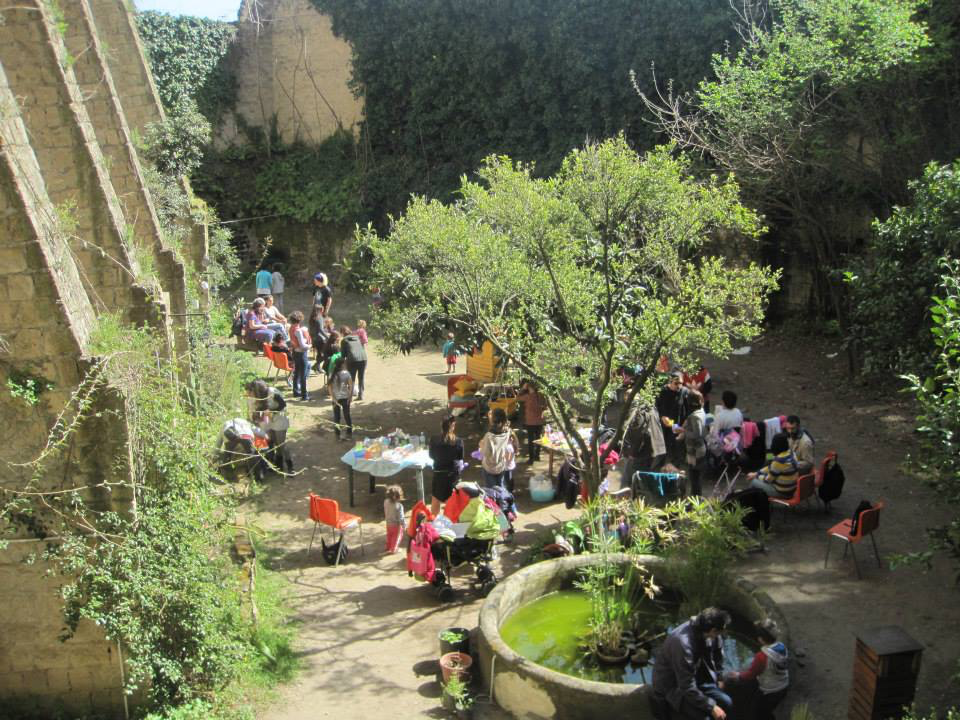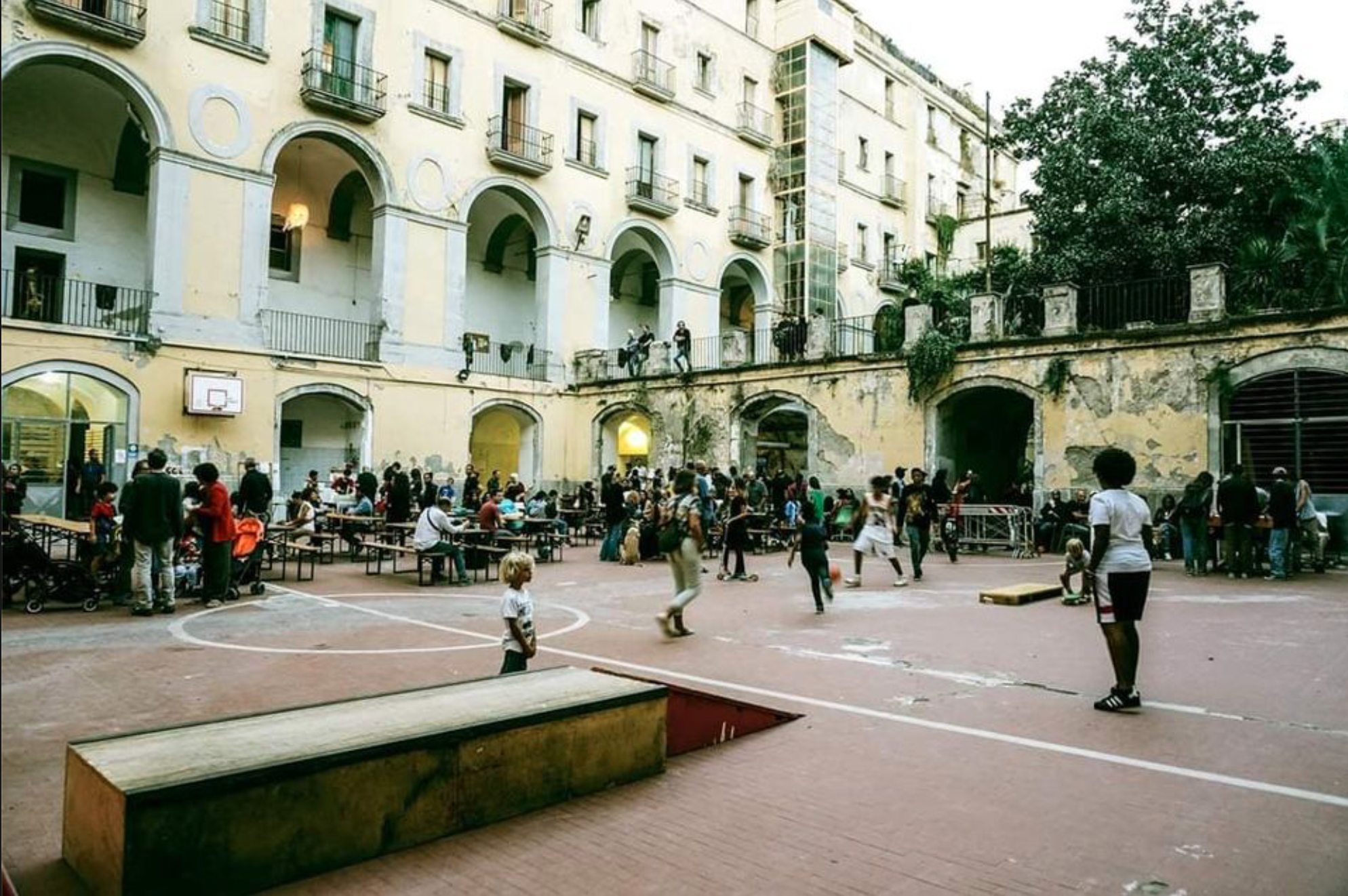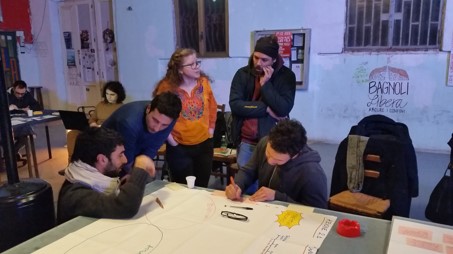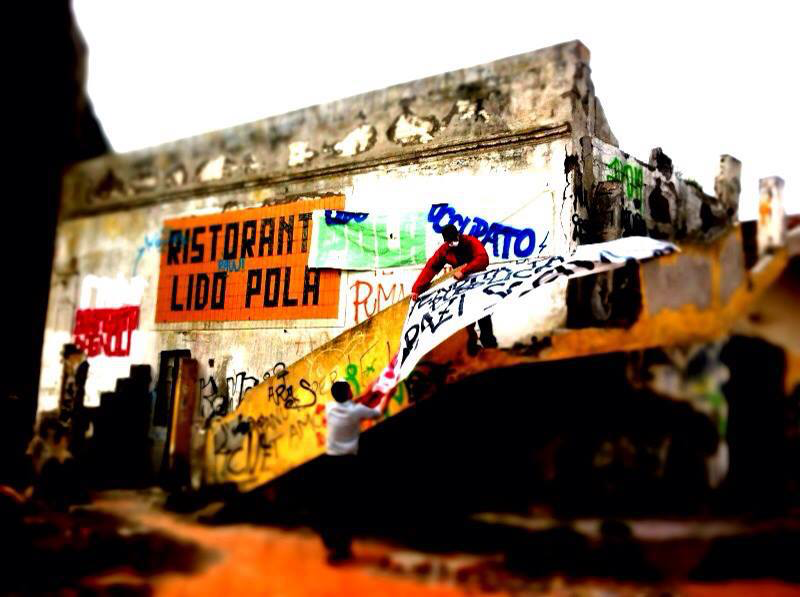Enhancing the care of the city: Naples Transfer Story
Edited on
04 June 2021In 2018 the city of Naples was awarded by URBACT for its model of “civic uses”, a policy tool that enables communities of citizens to manage and take care of public assets – known as urban commons – in a democratic way. Naples has recognised the "Urban Civic Use Regulation" of common goods in the city itself, and thanks to the good practice's governance model, more than 250 projects came to life, breaking down the production costs by using free and shared spaces, resources, knowledge and skills.
During the last decade, the City of Naples has been experimenting with this new governance model to get back in use abandoned or underused buildings subtracted from the life of the city. Conflictual actions of occupation and bottom-up rule-creation were turned into an opportunity.
This legal tool was theorized from the grassroots, claimed by commons activists that revisited the ancient Italian legal institution of “civic use”, encourages the ability of citizens to find innovative solutions for the reuse of public abandoned assets and guarantees autonomy of the communities involved.
The civic use of empty buildings, in fact, implies a temporary use and represents a starting point for innovative mechanisms of regeneration as a community-managed or a community-managed estate. Therefore, the legal model adopted by the municipality therefore represents an overturn of institutional learning: participatory democracy tools were created by direct civic imagination and implemented by the City Government.
The Civic eState Network gave Naples the possibility to share this experience with other 6 cities – Amsterdam, Barcelona, Gdansk, Ghent, Iasi and Presov –, and learn from them on how to strengthen its “Good Practice”.

Drawing from the detailed analysis of the Good Practice, the object of the transfer was the following:
the urban co-governance principle in the use, management and ownership of urban commons and the creation of public through local legal hacks (such as the example of the urban civic uses successfully experimented in Naples).
Naples’ URBACT team tried to imagine what were the potentials and shared values behind the commons of the city by maintaining the freedom to act in terms of the groups recognized as users of the shared spaces, which can manage without interference from the Municipality.
With the urban planning counsellor, the URBACT Local Team identified 3 main points of improvement:
- the good practice itself: how can these places be self-financed and self-managed?;
- determine the shared responsibility in terms of maintenance, safety (fire), etc.;
- create an exchange with other EU cities and strengthen the model of the urban commons, avoid fragmentation between the spaces and the risk of institutional isolation. The overall objective was to understand how to make sure this becomes an administrative practice not confined within one department but able to go beyond political cycles.
These are the 3 main topics the city imagined at first, but they grew as Naples’s LAWG and the URBACT Local Group recognized more points to improve. URBACT has one key advantage: gives opportunities and exchanges to realize local action plans, and freedom to experiment with different social projects. Naples wanted to select both cities that have experience and expertise (like Barcelona, Amsterdam and Ghent) and cities that have different goals and could add different values. The cities that can get ahead are the cities that have an initial boost of support by the local government, but at the same time, this has the risk of keeping the practice contained within. When there are big changes during the transfer journey (a new mayor, for example) they lose speed: therefore, as Lead Partner, Naples needed to encourage experimentations on policies on a network level.

Giardino Liberato di Materdei, Naples
Enhancing the care of the city
Naples’ Good practice was born from an innovative dialogue between administration and citizens, which built a process of legal co-creation. Civic eState helped to maintain this dialogue, vital for the existence of the local network of urban commons.
The civic use model is a system of “direct administration” structured as a form of participatory governance that intends to go beyond the classic “concession agreement model”, based on a dichotomous view of the public-private partnership. This model recognizes the existence of a relationship between the community and the public assets that trigger the formation of a social practice eventually evolving into a “civic use”, which in essence is the right to use and manage the resource as shaped by its users.
To let this governance model grow, one of the main objectives of the Civic eState project has been how to create economies of scale and better management of urban commons, eventually by pooling resources and establishing forms of cooperation between the different urban commons.
By enhancing commoners' proposals and their active role in the “care of the City”, the Administration is also willing to promote new forms of "Urban Civic Communities" and to define schemes to gain the interest of long-term investors. In this way, the designed Civic Development environments would become a driver to boost the overall economic sustainability of the process and to promote innovative financing schemes.
As a matter of fact, according to empirical evidence, collective governance is more sustainable and long-enduring when resource pooling and cooperation between five possible categories of actors is in place: social innovators or the unorganized public, public authorities, businesses, civil society organizations, and knowledge institutions.
Right now, there is motivation to show that self-sustainability projects are a strong trend within different EU cities, not confined to just a few examples. Barcelona’s self-evaluation of co-managed spaces impressed Naples as a powerful tool to monitor urban commons and improve their transparency, but its implementation is challenging for the Italian city, where technical and political parts of the administration just started to talk to each other on the topic. During the Transfer process, it became clear the necessity to build a round table that included technical, political, and urban common stakeholders, to allow the city to focus on a few key objectives:
- building a strategy to promote this narrative;
- self-recovery of the assets;
- community empowerment and self-financing.
All those who participated in the process were not new to the topic of urban commons. What was new was this collaborative approach with the administration, and the urban common network worked together again after the collective writing of the Declaration of Use. The narrative of the urban commons movement was made clearer and shared within the URBACT Local Group.

Scugnizzo Liberato, Naples
Local Group Activities
The URBACT Local Group of Naples is composed of the “Urban Planning and urban commons Department” of Naples (the first department in Italy to have a specific mandate on urban commons), the Permanent Observatory on Urban Commons of the City of Naples (a consulting body composed by researchers and activists who are experts on the topic) and, last but not least, also the community of inhabitants of the urban commons of Naples were involved and hosted the meetings of the ULG. The URBACT Local Group has been crossed by 73 participants only in the co-design phase.

ULG session, 2019
The participatory process was organized in two main steps: the first year (from May 2019 to April 2020) was dedicated to the co-design of a Local Action Plan, while the second step (from May 2020 to June 2021) is being dedicated to the realization of the proposed actions.
The Local Action Plan identified 3 specific objectives and the relative actions that will be implemented within June 2021, in order to strengthen the urban commons network.
Communicate the commons network
The first identified objective was to improve the “Communication” of the urban commons of Naples, not only as a way to inform but also to involve actively other citizens in the network and also to help the “reproduction” of the network of the urban commons itself. In fact, the perception at the moment, more than a network, is of many different urban commons, each one with its specific mission, its peculiar activities and its own communication means, mostly on social networks.
Therefore, the first action that has been realized was aimed at improving the communication means of the network, through the realization of one shared website of the Urban Commons network of Naples, whose editorial committee is composed of activists belonging to the different commons of the city. The website is still in the trial version, its structure and contents are still being discussed by the urban commoners, but within the end of June it will be fully operational and translated in English in all its parts. Moreover, some communication contents were produced, in order to present the peculiarity of the urban commons network of Naples. Up to now, in fact, many legal and administrative documents have been produced but the storytelling of what the urban commons are was actually missing – how the self-management system works and how anyone can become part of it. Therefore, a set of documents for the general public is being published: Giuseppe Micciarelli – URBACT expert and also an activist of the urban commons network in Naples – offered his expertise to produce “an introduction to the urban commons practices” in English, in order to explain to local and international non-experts what has been achieved up to now in Naples on this topic; A documentary (already available on commonsnapoli.org) has been produced, with interviews to 14 activists of 7 different urban commons, to enjoy in-depth emotional storytelling of the reasons, desires and aspirations of the commoners of Naples.
Enabling self-construction and self-recovery
The second objective of the Local Action Plan is to recognize institutionally the practices of co-design, self-construction and self-recovery in the urban commons. Many urban commons are historical, listed buildings that belong to the built heritage of the city and most of them are in a very bad conservation state. The aim is to strengthen the local capacity (both administrative and of the local communities) in finding solutions to the physical deterioration of the urban commons. These solutions should be compatible with collective management and civic uses that are being experimented by the commoners.
The plan is to create a “Permanent roundtable” where the local communities of inhabitants are involved in the decision-making process related to extraordinary interventions on the urban commons and in the co-design and implementation of these interventions. A second step is to identify procedures for the maintenance and ordinary management of the building complexes, that involve both the administration and the commoners.
The final challenge is to allow self-construction/self-recovery interventions by the “community of inhabitants” themselves. This possibility at the moment does not exist according to the local regulations. Therefore, with the help of an urban expert, the ULG explored the procedural innovations already experimented on this topic by other Italian cities and we promoted a network of experts and leading actors of innovative self-construction experiences in Italy, in order to discuss this topic through interviews and public events. This research activity was preliminary to the elaboration of a document of guidelines for the local regulation of self-recovery and self-construction interventions for the urban commons, to introduce these innovative practices in the regulations of the city Naples.

Santa Fede Liberata, Naples
Community empowerment
The third Objective of the local action plan is related to “Community empowerment”. During the participatory process the activists of the urban commons expressed the need to improve their capacities and competencies in managing the urban commons. Self-assessment exercises highlighted first of all the need for capacity building on self-financing and grassroots fundraising. For this purpose, a very intense capacity building programme was offered to the activists, that included:
- a workshop of 24 hours on community fundraising, whose beneficiaries were 46 activists belonging to 22 urban commons and other non-profit organizations;
- tutoring of the activists in the operational planning of 5 pilot fundraising campaigns for 5 urban commons, for a total amount of almost 350.000 euros;
- a document elaborated by a senior fundraiser, who followed the whole training process, that contains specific guidelines for the fundraising of urban commons. This document will be widely disseminated as a useful toolkit for the commoners who want to try their hand at fundraising campaigns.
The communities of inhabitants of the urban commons have been involved by experts in workshops and focus groups that aimed at strengthening their capacities in community organizing and conflict resolution. These, in fact, are some pressing issues that emerged also by the bottom-up management.
All the activities of the ULG have been designed and implemented within 2 years with the limited budget offered by the URBACT programme (almost 40.000 euros in total). The general idea of the Local Action Plan was to define some guidelines for the further development of the urban commons’ experience in Naples, by putting seeds in the very short term.

Vision
The mechanism proposed by the City of Naples, although routed in the Italian legal system, is characterized by a high degree of adaptability to other European urban contexts as it is based on largely shared ethic, legal and social values, already widespread in other countries (especially in UK, France, Belgium Spain and Portugal). Both civic uses and the basic design principle of this policy and legal tool are already at the core of many local policies. In these years, moreover, many meetings, conferences and working groups arose between the Neapolitan community of civic users and Italian and European commons movements.
The mobility of this good practice encourages a mutual learning process on innovative tools to foster an integrated approach in urban regeneration and redevelopment processes.
The transfer cities help build and establish generating new community-led sustainability models through a non-conflictual process of dialogue with and cooperation among citizens. As already noted, this process makes bottom-up initiatives recognizable by the city administration for their inner value, ensuring the autonomy of both parties involved, on the one hand, the citizens engaged in the reuse of common goods and on the other hand the city administration.
 Submitted by Gregorio Turolla on
Submitted by Gregorio Turolla on
